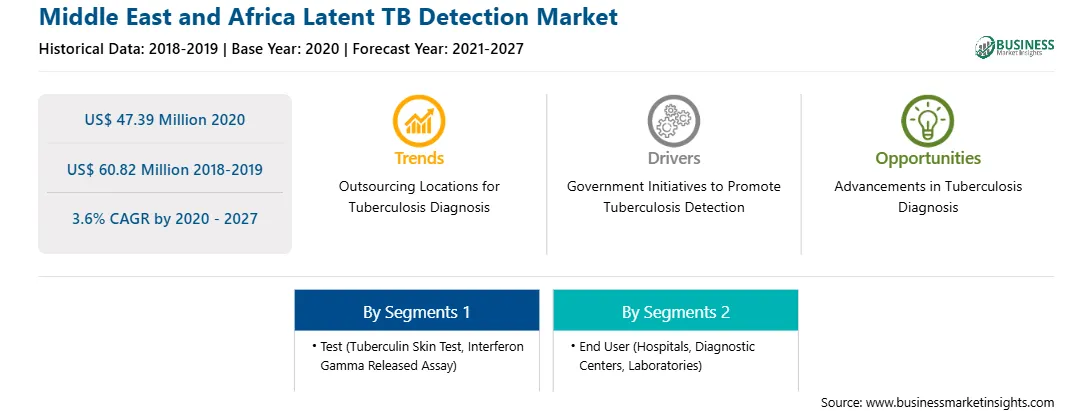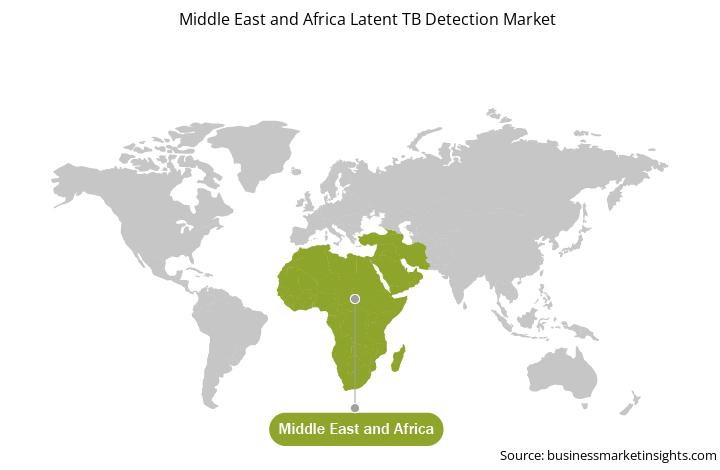MEA consists of three major countries namely United Arab Emirates (UAE), Saudi Arabia and South Africa. The UAE is the largest market for Latent TB Detection across the region. UAE has one of the most advanced healthcare infrastructures in the region. With the UAE Vision 2021 National Agenda, the country is aiming to achieve a world-class healthcare system and establish itself as a pioneer healthcare destination in the region. As per the Arab health, the UAE's healthcare sector is already witnessing a structural shift with a strong growth forecast in the next five years reaching AED103 billion ($28 billion) by 2021. As per the WHO, tuberculosis remains present in the country at negligible rates, in 2018, 2 cases per 100 000 population were recorded in the county. The country has very efficient health structure. The health sector in the UAE is administered by two authorities, the Ministry of Health for regulating the public health sector and the Emirates health authorities responsible for service delivery at state level. Health care is provided for all nationals and health insurance is mandatory for non-nationals. Moreover, the country is one of the biggest supporters of TB elimination programs. For instance, In September 2018, UAE Ministry rolled out TB awareness campaign to target eradication of TB in UAE through education, prevention, and proper treatment. Also, the UAE has pledged US$ 59.22 million for the Global Fund’s Sixth Replenishment, for 2020-2022. Burgeoning market in emerging economies and rising advancements in tuberculosis diagnosis are the major factor driving the growth of the MEA latent TB detection market.
In case of COVID-19, MEA is highly affected especially South Africa. Economic uncertainties and ongoing conflicts are worsening the condition in the region. For instance, countries such as Syria, Libya, and Yemen are suffering violent conflict and cannot implement any public health measures. Iran was in deep economic recession due to the US sanctions. Also, the major source of economic stabilization in Middle East countries is oil production and export. However, the recent pandemic is causing turbulence to the economies of the Middle East region. A sudden drop in domestic and external demand for goods and products, especially crude oil, and halted production due to labor shortage, are major impacts observed in the region. Additionally, tightened financial condition is also decreasing the economic activities in the region. Since the beginning of 2020, the COVID-19 pandemic has caused enormous health, social and economic impacts, which are likely to continue in 2021 and beyond. Even after some of these impacts have been mitigated or contained, there will be medium- and longer-term consequences, including for the TB epidemic and response. The pandemic threatens to reverse the progress made towards TB targets by the end of 2019. With many laboratory services under acute pressure, new TB case notifications in some places have dropped by up to 75%.

Strategic insights for the Middle East and Africa Latent TB Detection provides data-driven analysis of the industry landscape, including current trends, key players, and regional nuances. These insights offer actionable recommendations, enabling readers to differentiate themselves from competitors by identifying untapped segments or developing unique value propositions. Leveraging data analytics, these insights help industry players anticipate the market shifts, whether investors, manufacturers, or other stakeholders. A future-oriented perspective is essential, helping stakeholders anticipate market shifts and position themselves for long-term success in this dynamic region. Ultimately, effective strategic insights empower readers to make informed decisions that drive profitability and achieve their business objectives within the market.

| Report Attribute | Details |
|---|---|
| Market size in 2020 | US$ 47.39 Million |
| Market Size by 2027 | US$ 60.82 Million |
| Global CAGR (2020 - 2027) | 3.6% |
| Historical Data | 2018-2019 |
| Forecast period | 2021-2027 |
| Segments Covered |
By Test
|
| Regions and Countries Covered | Middle East and Africa
|
| Market leaders and key company profiles |
The geographic scope of the Middle East and Africa Latent TB Detection refers to the specific areas in which a business operates and competes. Understanding local distinctions, such as diverse consumer preferences (e.g., demand for specific plug types or battery backup durations), varying economic conditions, and regulatory environments, is crucial for tailoring strategies to specific markets. Businesses can expand their reach by identifying underserved areas or adapting their offerings to meet local demands. A clear market focus allows for more effective resource allocation, targeted marketing campaigns, and better positioning against local competitors, ultimately driving growth in those targeted areas.

The MEA latent TB detection market is expected to grow from US$ 47.39 million in 2020 to US$ 60.82 million by 2027; it is estimated to grow at a CAGR of 3.6% from 2020 to 2027. Escalating government initiatives to promote tuberculosis detection is expected to drive the market growth. The disease disproportionally affects the poor, vulnerable, undernourished, and marginalized people. Evidence from various sources such as World Health Organization (WHO) and the United Nations (UN) shows that countries such as Nigeria and South Africa are highly populated with patients suffering from TB. Thus, the government bodies in these countries are undertaking and adopting certain schemes and initiatives in containing the disease. Several schemes has been introduced for patients suffering from TB. Several policies involves direct transfer of cash to the victim’s account intended for TB diagnostic tests, treatments, and medication costs. Furthermore, countries such as UAE and Saudi Arabia are giving significant importance in combating TB by undertaking various funding programs. Thus, the financial and medical assistance from the governments for fighting the disease and promoting the diagnosis of TB is providing a lucrative scenario for the growth of the MEA market.
In terms of test, the tuberculin skin test (TST) segment accounted for the largest share of the MEA latent TB detection market in 2019. In terms of end user, the hospitals segment held a larger market share of the MEA latent TB detection market in 2019.
A few major primary and secondary sources referred to for preparing this report on the MEA latent TB detection market are company websites, annual reports, financial reports, national government documents, and statistical database, among others. Major companies listed in the report are Abbott; ARKRAY, Inc.; BD; bioMerieux SA; F. HOFFMANN-LA ROCHE LTD.; Oxford Immunotec Ltd; QIAGEN; and Serum Institute of India Pvt. Ltd.
The Middle East and Africa Latent TB Detection Market is valued at US$ 47.39 Million in 2020, it is projected to reach US$ 60.82 Million by 2027.
As per our report Middle East and Africa Latent TB Detection Market, the market size is valued at US$ 47.39 Million in 2020, projecting it to reach US$ 60.82 Million by 2027. This translates to a CAGR of approximately 3.6% during the forecast period.
The Middle East and Africa Latent TB Detection Market report typically cover these key segments-
The historic period, base year, and forecast period can vary slightly depending on the specific market research report. However, for the Middle East and Africa Latent TB Detection Market report:
The Middle East and Africa Latent TB Detection Market is populated by several key players, each contributing to its growth and innovation. Some of the major players include:
The Middle East and Africa Latent TB Detection Market report is valuable for diverse stakeholders, including:
Essentially, anyone involved in or considering involvement in the Middle East and Africa Latent TB Detection Market value chain can benefit from the information contained in a comprehensive market report.